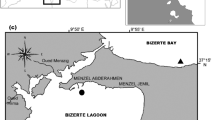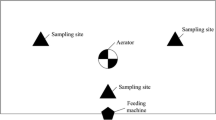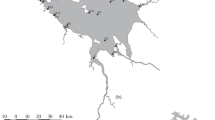Abstract
The quantitative role of bacteria in the carbon cycle of ponds used for culture of penaeid prawns has been studied. Bacterial biomass was measured using epifluorescence microscopy and muramic acid determinations. Bacterial growth rates were estimated from the rate of tritiated thymidine incorporation into DNA. In the water column, bacterial numbers ranged from 8.3×109 1−1 to 2.57×1010 1−1 and production ranged from 0.43 to 2.10 mg Cl−1 d−1. In the 0–10 mm zone in sediments, bacterial biomass was 1.4 to 5.8 g C m−2 and production was 250 to 500 mg C m−2 d−1. The results suggested that most organic matter being supplied to the ponds as feed for the prawns was actually being utilized by the bacteria. When the density of meiofauna increased after chicken manure was added, bacterial biomass decreased and growth rates increased.
Similar content being viewed by others
References
Bell RT, Ahlgren GM, Ahlgren I (1983) Estimating bacterioplankton production by measuring [3H]thymidine incorporation in a eutrophic Swedish lake. Appl Environ Microbiol 45:1709–1721
Bratbak G, Dundas I (1984) Bacterial dry matter content and biomass estimations. Appl Environ Microbiol 48:755–757
de Jonge VN, Bouwman LA (1977) A simple density separation technique for quantitative isolation of meiobenthos using colloidal silica Ludox-TM. Mar Biol 42:143–148
Delmendo MN (1980) A review of integrated livestock-fowl-fish farming systems. In: Pullin RSV, Shehadeh ZH (eds) Integrated agriculture-aquaculture farming systems. ICLARM Conference Proceedings 4. International Center for Living Aquatic Resources Management, Manila and the Southeast Asian Center for Graduate Study and Research in Agriculture, College, Los Banos, Laguna, Philippines, pp 59–71
Ducklow HW (1982) Chesapeake Bay nutrient and plankton dynamics. 1. Bacterial biomass and production during spring tidal destratification in the York River, Virginia, estuary. Limnol Oceanogr 27:651–659
Fallon RD, Newell SY, Hopkinson CS (1983) Bacterial production in marine sediments: will cell-specific measures agree with whole-system metabolism? Mar Ecol Prog Ser 11:119–127
Fenchel T, Harrison P (1976) The significance of bacterial grazing and mineral cycling for the decomposition of particulate detritus. In: Anderson JM, Macfadyen A (eds) The role of terrestrial and aquatic organisms in decomposition processes. Blackwell, Oxford, pp 286–299
Fenchel T, Jorgensen BB (1977) Detritus food chains of aquatic ecosystems: the role of bacteria. Adv Microb Ecol 1:1–58
Fuhrman JA, Azam F (1980) Bacterioplankton secondary production estimates for coastal waters of British Columbia, Antarctica, and California. Appl Environ Microbiol 39:1085–1095
Fuhrman JA, Azam F (1982) Thymidine incorporation as a measure of heterotrophic bacterioplankton production in marine surface waters: evaluation and field results. Mar Biol 66:109–120
Lee JJ (1980) A conceptual model of marine detrital decomposition and the organisms associated with the process. In: Droop MR, Jannasch HW (eds) Advances in aquatic microbiology, vol. 2. Academic Press, London, New York, Toronto, Sydney, San Francisco, pp 257–291
Middleton AC, Lawrence AW (1977) Kinetics of microbial sulfate reduction. J Water Pollution Control Federation, 49:1659–1670
Moriarty DJW (1980) Measurement of bacterial biomass in sandy sediments. In: Trudinger PA, Walter MR, Ralph BJ (eds) Biogeochemistry of ancient and modern environments. Canberra, Australian Academy of Science, pp 131–138
Moriarty DJW (1983) Measurement of muramic acid in marine sediments by high performance liquid chromatography. J Microbiol Methods 1:111–117
Moriarty DJW (1984) Measurements of bacterial growth rates in some marine systems using the incorporation of tritiated thymidine into DNA. In: Hobbie JE, Williams PJLeB (eds) Heterotrophic activity in the sea. Plenum Press, New York, pp 217–231
Moriarty DJW, Cook HL, Hassan Rosly bin, Thanabal M (in press) Primary production and meiofauna in some penaeid prawn aquaculture ponds at Gelang Patah. Malaysian Agricultural Journal
Moriarty DJW, Hayward AC (1982) Ultrastructure of bacteria and the proportion of gram-negative bacteria in marine sediments. Microb Ecol 8:1–14
Moriarty DJW, Pollard PC (1981) DNA synthesis as a measure of bacterial productivity in seagrass sediments. Mar Ecol Prog Ser 5:151–156
Moriarty DJW, Pollard PC (1982) Diel variation of bacterial productivity in seagrass (Zostera capricorni) beds measured by rate of thymidine incorporation into DNA. Mar Biol 72:165–173
Payne WJ (1970) Energy yields and growth of heterotrophs. Ann Rev Microbiol 24:17–52
Pollard PC, Moriarty DJW (1984) Validity of the tritiated thymidine method for estimating bacterial growth rates: the measurement of isotope dilution during DNA synthesis. Appl Environ Microbiol 48:1076–1083
Riemann B, Sondergaard M (1984) Measurements of diel rates of secondary production in aquatic environments. Appl Environ Microbiol 47:632–638
Schroeder GL (1978) Autotrophic and heterotrophic production of microorganisms in intensely-manured fish ponds, and related fish yields. Aquaculture 14:303–325
Schroeder GL (1983) Sources of fish and prawn growth in polyculture ponds as indicated by C analysis. Aquaculture 35:29–42
Simpson HJ, Ducklow H, Deck B, Cook HL (1983) Brackish-water aquaculture in pyritebearing tropical soils. Aquaculture 34:333–350
van Es FB, Meyer-Reil L-A (1983) Biomass and metabolic activity of heterotrophic marine bacteria. Adv Microb Ecol 6:111–170
Widdel F, Pfennig N (1981) Studies on dissimilatory sulfate-reducing bacteria that decompose fatty acids. I. Isolation of new sulfate-reducing bacteria enriched with acetate from saline environments. Description ofDesulfobacter postgatei gen. nov., sp. nov. Arch Microbiol 129:395–400
Zimmerman R, Meyer-Reil L-A (1974) A new method for fluorescence staining of bacterial populations on membrane filters. Kieler Meeresforsch 34:24–27
Daley RJ, Hobbie JE (1975) Direct counts of aquatic bacteria by a modified epi-fluorescence technique. Limnol Oceanogr 20:875–881
Author information
Authors and Affiliations
Rights and permissions
About this article
Cite this article
Moriarty, D.J.W. Bacterial productivity in ponds used for culture of penaeid prawns. Microb Ecol 12, 259–269 (1986). https://doi.org/10.1007/BF02011169
Issue Date:
DOI: https://doi.org/10.1007/BF02011169




